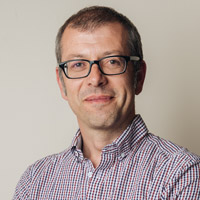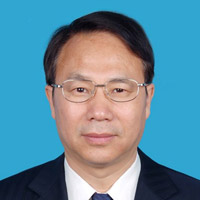
Professor Bruce Drinkwater
B.Eng., Ph.D.(Lond.)
A.C.G.I., D.I.C.
C.Eng., F.I.Mech.E., F.Inst.NDT, M.Inst.P.
Title: Defect Characterisation using ultrasonic arrays – fundamental limitations and future possibilities
Abstract
The use of ultrasonic arrays for imaging in NDT applications is now widespread. The last decade has seen significant research progress in parallel with industrial uptake. Arrays offer an intuitive view of the interior of a component from which geometric features and defects can be observed. Arrays also offer unprecedented information about the nature and extent of any defects. It is this ability of arrays to characterise and size defects that is the topic of this lecture.
When an ultrasonic array illuminates a defect the received signals depend on the defect reflectivity which is itself a function of both the incoming and scattered angles. In essence, the array illuminates the defects from a range of angles and thereby examines a small portion of the defect’s scattering matrix. These scattered signals are useful as they encode information about the characteristics of the defect. The question then is, given some array reflectivity measurements can the defect be characterised and sized uniquely? The full answer to this question is still unclear, but fortunately, in most NDT applications, something definite is known about the possible types of defect. This knowledge unlocks the problem and leads to the general approach described here in which array scattering data is compared to simulations of scattering from possible defects. The closest match is then the characterisation result. Here we show that using this approach, coupled with additional information about the range of possible defects, accurate characterisation is possible even for defects that are fractions of a wavelength in size.
In any real ultrasonic array inspection some noise is always present and this sets a lower limit on what characterisation performance is possible. But also, as defects become smaller relative to the wavelength, their scattering behaviours become increasingly similar. When taken together, these two pieces of information lead to a fundamental limit on the characterisation performance that can be achieved with any linear imaging algorithm.
Recently it has been shown that the same ultrasonic array data that can be used for the above linear imaging and characterisation, also contains information about the nonlinearity of the defects. This future possibility represents a way to move beyond the fundamental limits imposed by linear scattering. The nonlinear information encodes new characterisation information such as crack tip closure which is crucial in structural integrity assessments. The exciting prospect is that this new information can be obtained from commercially available array equipment at little additional cost, a rare case of physics giving “something for nothing”.
Biography
In 1996, after obtaining B.Eng. and Ph.D. degrees from Imperial College, London, UK, he joined the Mechanical Engineering Department at the University of Bristol, UK, where he has remained. He was promoted to Professor of Ultrasonics in 2007 and now leads the Ultrasonics and NDT research group at Bristol. He has been involved in a diverse range of engineering topics including NDT&E, condition monitoring as well as ultrasonic levitation, tractor beams and haptics. He has worked on ultrasonic array imaging in 2000 and this is a common theme that now links together many of his research interests. Over the last 10 years he has been part of the UK Research Centre in NDE, where he has collaborated closely with industry to progress his research ideas into industrial reality. As a result, the ultrasonic imaging methods and algorithms he helped develop are now in widespread use by industry where they have improved the safety of aircraft, power stations and other complex engineering structures. His work has contributed to the detection of smaller defects than were previously possible and significantly improved defect sizing through the development of algorithms known as Full Matrix Capture (FMC) and the Total Focusing Method (TFM). This work has not only improved safety but has also opened up a new area of research and development. He has been involved in significant commercial impact, achieved through instrument sales, cost savings from reduced inspection time and reduced failure rate of components. For example, he commercialised an array-wheel device which dramatically reduced composite aircraft component inspection times. He actively engages with schools and the general public about engineering, acoustics and NDT through public talks and articles as well as developing hands-on exhibits.

Ajit Mal
Distinguished Professor and Vice Chair
Director, Online MS Programs in Mechanical Engineering
Mechanical and Aerospace Engineering Department University of California, Los Angeles, CA 90095-1597
ajit@g.ucla.edu
Title: Ultrasonic NDE of Composite Structures
Abstract
Composite materials are being used increasingly in a variety of aircraft and aerospace structures due to their high strength to weight ratio. They are, however, susceptible to internal defects that can occur during manufacturing of the structural components or during service of the structure. Hidden defects, if undetected, may grow during service, become unstable and result in a catastrophic failure of the composite structure. Thus, composite structures require extensive periodic or continuous monitoring throughout the life of the structure to detect the initiation and growth of defects at an early stage of their occurrence. Ultrasonic methods offer a cost-effective method to achieve this goal. A good understanding of the highly complex characteristics of ultrasonic waves in composite structures is a perquisite to developing a reliable nondestructive inspection technology for composite structures. This talk presents an overview of the work carried out by the speaker and his associates on the characteristics of ultrasonic waves that can propagate in plate-like composite structural components using a combination of analytical, numerical and experimental methods. No attempt is made here to provide a comprehensive review of the NDE of composite structures.
Biography
Professor Mal received his Ph.D. in Applied Mathematics/Mechanics from Calcutta University in 1964, did postdoctoral research at UCLA and UC Berkeley and joined the faculty at UCLA as an Assistant Professor of Engineering in 1967. He became a full professor in 1974 and is currently a Distinguished Professor, a special rank reserved for "scholars and teachers of the highest international distinction". Professor Mal’s research interests are in the general area of Structural and Solid Mechanics. He has made major research contributions in nondestructive evaluation (NDE) of defects in metallic and composite structures. He has authored or coauthored a graduate textbook in Solid Mechanics, over 150 journal papers, 5 research monographs and made over 150 technical presentations at conferences, seminars and symposia. His honors and awards include a senior Fulbright Fellowship to Germany, election to the Fellow status of the American Academy of Mechanics (AAM), American Society of Mechanical Engineers (ASME) and the International Society of Optical Engineers (SPIE). He also received the Lifetime Achievement Award of SPIE and the Founder’s Award of the NDE Division of ASME.

Xiuming Wang
Institute of Acoustics
Chinese Academy of Sciences
Title: Borehole Acoustics and its Applications
Abstract
Borehole acoustics is engaged in studies of acoustic waves and waveguides in a borehole. It is used in quantitative evaluations of the oil-well integrity and formation properties in the vicinity of a borehole. In this presentation, I will give a brief review on borehole acoustics and its applications.
The borehole acoustic fields contain the guided waves along the cylindrical wellbores and the reflection echoes from the formations. One can evaluate the mechanical properties of surrounding media by inversions from the received sonic logging signals. The necessary detections include porosity, permeability, geo-stresses, geological structures, and defects in cased wells. Those are crucial for the oil/gas productivity. To reveal the quantitative correlation between the field data and the downhole formations, wave propagation in various complex models were investigated over the years. Those academic issues of borehole acoustics focus on anisotropy media, saturated porous media, crack/cave scattering, eccentric tools, directional transducers, etc. The early developed downhole techniques were mostly based on wireline logging. In recent years, the acoustic logging while drilling became a frontier application. The collar waves propagating along the tools and the formation responses extracted from the strong noises are the critical research topics. The scientific research on above problems greatly promotes the development of downhole acoustic measurement techniques. I will introduce two applications, i.e., Imaging behind casing and far acoustic wave detection.
Good cement bond quality is essential for an oil well to prevent hydraulic communication between zones and to ensure layered exploitation. Conventional sonic logging techniques mainly record the amplitude of the casing arrivals, limited to the detection region immediately behind the casing. They can hardly be used to evaluate bonding quality between cement and formations. The ultrasonic technique based on the leaky Lamb waves is a potential solution for quantitative detection of the whole annulus. It is possible for integrated evaluation for both surfaces of the cement annulus by extracting attenuation properties of the Lamb waves.
The other novel application of downhole measurements demonstrated here is the far acoustic wave detection. Traditional sonic logs are only concerned with the near-borehole properties, with very limited detection depths no more than one meter, by extracting the direct waves propagating in wellbores. The far acoustic wave detection is a new technique to acquire images of the structures, with several tens of meters from the borehole, by the reflection wave migration. With improvements of acoustic sensor techniques, the means of the far acoustic wave detection with omnidirectional, cross-dipole, and phased array transducers have been investigated, respectively. The far distance detection tools with multi-component sensors are being developed, which have potentials to eliminate the azimuth ambiguity of reflection imaging.
Biography
Prof. Xiuming Wang obtained his PhD in acoustics from University of the Chinese Academy of Sciences (UCAS) in 1995. He worked as assistant professor, associate professor, and full faculty professor in Northeast Petroleum University in China from 1991 to 1999. He worked as a visiting scholar and post-doc in Stanford University from 1998 to 1999. After that, he served for Commonwealth Scientific and Industrial Research Organization (CSIRO) of Australia as a scientist, senior scientist, and principal Scientist from 1999 to 2006. He has worked with the Institute of Acoustics in Chinese Academy of Sciences (IACAS) as a professor and laboratory director since 2006. Currently, he is a professor and director of the Research Center for Ultrasonics and Technologies in IACAS. He is the founder and director of Beijing Engineering Research Center for Deep Drilling Exploration. His scholar positions also include the standing committee member of the Acoustical Society of China (ASC), director of NDT Acoustics in ASC, Editor in Chief for the Journal of Applied Acoustics, and Deputy Editor in Chief for Chinese Journal of Acoustics. He was elected as the ICU standing committee member in 2017. He received the highest acoustics reward of Dah-You Maa from the Acoustical Society of China in 2012. His research interests are acoustic waves and waveguides in solids, ultrasonics and ultrasonic imaging, borehole acoustic logging, and petrophysics. He co-authored over 150 papers, and held tens of patents.